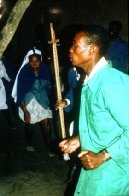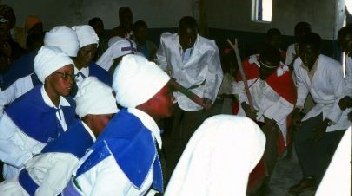© 2023 Dr Margaret Sheppard
Zion Christian Churches
Brief Overview
Please see following sub sections for details of the beliefs and practices of the two main types of Zion Churches. Each type has off-
Traditionally, religion which included medical services was closely interwoven with everyday life. For example traditionally incidents such as human sickness, stock death, bad luck, crop failure etc., were often seen as mere symptoms of a deeper under-
However, traditional religions, may fail to present adequate systems suited to "modern" Africa where the former isolated microcosmic societies have become increasingly affected by, and absorbed into, the large scale macrocosm of their nation and the international and global community.
This is a brief background of the circumstances in which new religious movements such as Zion Churches have developed. Exploratory research has tentatively suggested that these new religious movements may well provide a system to fulfil the local needs of a belief system and at the same time the needs created by the "new" situation that has resulted through social change. It was within this context that Christian churches such as the various Zion Christian Churches emerged.
In the following sections, some of the Zion Christian Churches will be outlined and it will be seen how they not only fulfil a need to satisfy the requirements of both traditional values and beliefs but also those of the “modern age” for their congregations. This perhaps demonstrates that far from exhibiting an example of social change they in fact exhibit a social continuity.
The Zion churches, despite their name, are black Christian churches, which although they seem to have grown rapidly in the 1920's and 1930's, have much earlier roots. Sundkler took down from information he obtained from "first-
Sundkler states that most of the present day Zion Churches can be traced back to off-
The name Zion comes from an idea originating from Zion City, Lake Michigan, Illinois, D.S.A., but members claimed that it is from Mount Zion in Jerusalem. Again according to Sundkler, by including the name "Zion" in the name of a church, the leader of a Zionist Church "defines it as a New,Testament church which in minute detail carries out the religious programme supposed to have been laid down by the central figure of the Zionist's Bible, John the Baptist. In fact very few of my informants were aware of these early beginnings and never mentioned any of the above-
Black workers were worried about the conditions and some started Zion Churches, which were totally organized and run by black people. The Bible is claimed to be the absolute authority but, as will be noticed traditional doctors and Zion prophets seem to perform many of the same functions. Although it would be an over-
However a Zionist is unlikely to seek the help of a traditional doctor in the case of sickness, as the use of traditional medicines, particularly the “horned" ones* (those associated with harming and stored in a lenaka -
It should be mentioned that in many ways the "ritual" and behaviour of a Zion prophet is probably influenced by that of traditional doctors. This will be seen in more detail in the following descriptions of the various services and "healing cures.", which may be compared with those described in the sections on traditional practices.
Many of the Zion Churches are quite small and may only have one congregation of 20-
1. Faith Healing.
2. Presence of prophets.
3. Use of drums.
4. Dancing and spirit possession during services.
5. Insistence on Total Immersion Baptism.
6. Holy Communion services at night only.
7. Wearing of special uniform
(N.B.These seven features are identified by Martin West)
Emergence of Zion Churches in Botswana
The Zion Churches were introduced into Botswana by returning migrant workers, particularly those who worked in the mines. They had joined a Zion Church whilst working in South Africa and so when they came home to Botswana they would either start a branch of their South African parent church or may even start their own church in Botswana.
At first these Zion Churches were outlawed in Botswana. In Kanye neighbours would report Zionists to the Chief. They were disliked by mission church members, who believed them to be more heathen than Christian, and by traditionalists, who feared that their Zion protections were causing problems in the kgotla (community of patrilineal kin) (e.g. the Zionists use of Zion Holy Water to protect their houses, families and property, rather than traditional medicines, was believed to attract lightning and misfortune to the whole kgotla.
At one time Zionists were even banished from Kanye in much the same way as sorcerers had been exiled. There is, for instance, a village called Metlobo on the edge of the Southern (Bangwaketse) District, that was originally started by Zionists who had been banished. Other Zionists decided to move to sub-
Since independence persecution has stopped. People are now free to practise Zionism and in the same way as traditional doctors are able to register their churches at the Ministry of Home Affairs, so also may Zion Churches. Registration is what each church strives to achieve. In Kanye there are many different Zion Churches, some are branches of churches in South Africa while others may be branches of churches which have started in Botswana, others have only one church, in Kanye. Some, whilst being independent of each other, join together into associations for joint services and activities.
Although all the Zion churches have most of the seven basic features there appear to be three basic types:
]. Zion Christian Church (Z.C.C.)
2. Zion Churches that do not use drums or have very much dancing.
3. Those Zion Churches that do use drums and do dance. These may be further sub-
a) Those that believe in sacrifice.
b) Those that do not~believe in sacrifice.
3.a) and 3.b) are classified together because, although they do not agree over belief about sacrifice, they often join together for certain special services, whereas they do not join with category 1, and 2. for joint services.










Further Selected Reading:
Sundkler, Bengt (1961. First Pub. 1948) Bantu Prophets in South Africa Oxford University Press.
West, Martin (1975) "The Shades Come to Town: The Ancestors and Urban Independent Churches" in Religion and Social Change in Southern Africa (Eds) Whisson, M.G. and Martin West
(1975) Bishops and Prophets in a Black City. Rex Collings: London.
Concluding Remarks
In these five churches all seven of West's features were found. The main distinction was whether or not sacrifice was practised. As all of these churches had branches, their social structure has developed beyond that of a Prophet Movement to that of a Religious Society. The special relationship that seemed to exist between BUCZ and Kanana churches indicates that in some ways BUCZ could be said to be an Ancillary Cult of Kanana, its members attending services at both. As there is no development as yet of a Holy City or New Jerusalem (as, for example with the Z.C.C. and Moria) these five churches have not developed into the Total Community Type. Special services where all the branches of one church come together for a joint service, such as at the annual church conferences, normally rotated between branches, who take it in turns to act as hosts.
ZION CHURCHES THAT INCLUDE DANCING AND USE OF DRUMS
These churches can be further sub-
Episcopal Apostolic Church in Zion of Africa -
Bethleham City of Christ Church in Zion of Africa -
Botswana United Church jn Zion -
God is Love/Kanana -
Apostolic Africa Christ Church in Zion -
All these churches had a basically similar pattern of ritual but first it is perhaps interesting to look at each in turn and at its leading Moruti (Priest).
Fuller details of these churches , are outlined in the following sections.